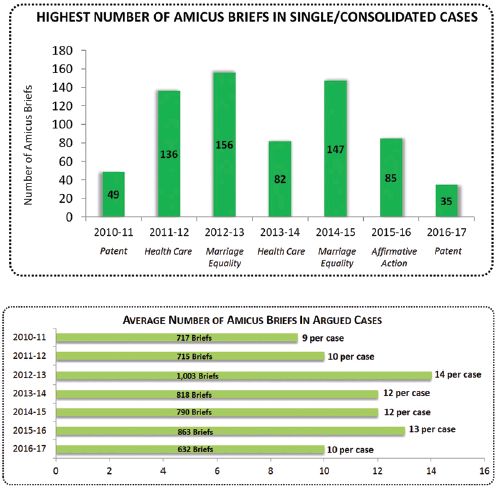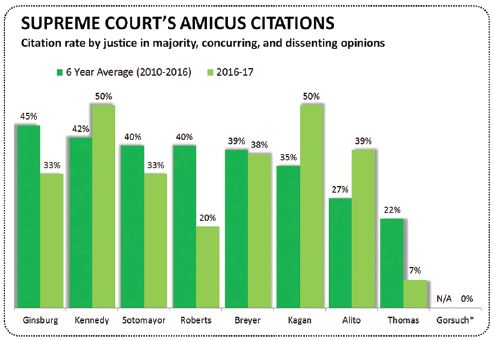The 2016–17 term was a quiet one at the Supreme Court. Shorthanded with only eight justices for most of the year, the Court seemed intent on keeping things lowkey— not a single blockbuster case— perhaps in an effort to avoid the 4-4 decisions that dogged the prior term. Without as many polarizing issues on the docket, the Court issued unanimous decisions in more than half its cases. All of this seemed to have an effect on amicus curiae. In our seventh year analyzing the Supreme Court's amicus docket for the National Law Journal, we found that friends of the court filed fewer briefs—and the justices cited them less often—putting the brakes on the record-setting trend in amicus participation from the previous six terms.
FEWER BRIEFS
The past six terms saw a record number of amicus briefs, with friends of the court filing between 715 and 1003 briefs in argued cases. That's "over an 800% increase from the 1950s and a 95% increase from 1995." Allison Orr Larsen & Neal Devins, The Amicus Machine, 102 Va. L. Rev. 1901, 1902 (2016). But in 2016–17, amici filed only 643 briefs in cases set for argument. Excluding the one appeal dismissed before argument, the number drops to 632 briefs, the lowest in seven terms.

The 2016–17 term also marked a seven-year low in the maximum number of briefs filed in a single or consolidated case. The prior terms set records with amici often filing briefs in the triple digits. In 2011–12, amici filed 136 briefs in the consolidated challenges to the Affordable Care Act (NFIB). In 2012–13, amici filed 156 briefs in the marriage-equality cases (Windsor and Perry). In 2013–14, amici filed 82 briefs in another ACA case (Hobby Lobby). In 2014–15, amici rebounded with 147 amicus briefs in the most recent marriage- equality case (Obergefell). And in 2015–16, amici filed 85 briefs in an affirmative-action case (Fisher).
But in 2016–17, with no marquee cases attracting a broad range of interests, the high mark was 35 briefs in a case concerning the patent exhaustion doctrine (Impression Products).
Still, even without a major case to increase the overall numbers, the 2016–17 term had an average of 10 amicus briefs per argued case. That is lower than recent terms, but in line with averages from 2010–12. And although amici filed fewer briefs, they participated in 98 percent of argued cases. In the prior six terms, participation rates ranged from 92 to 98 percent. The lone case without amicus participation was Manrique v. United States, an appeal brought by an in forma pauperis inmate concerning a deferred restitution award. Amicus participation was in fact substantially lower in the Court's eight pauper appeals, which involved criminal law or detention issues, averaging only 3.5 amicus briefs per case.

HOW THE JUSTICES USED THE BRIEFS
In 2016–17, justices cited amicus briefs in 24 majority opinions, as well as in eight dissents, three concurrences, and one opinion concurringin-part/dissenting-in-part. Overall, amicus briefs were cited in half (30/60) of the cases with amicus participation and signed majority opinions. That was a slight drop from the 2015–16 term, where justices cited briefs in 54 percent of cases, and on the low end of the past six terms where the justices cited amicus briefs in 46 to 63 percent of cases.
In 2016–17, the justices cited 6 percent (32/538) of the nongovernment "green briefs" (so called for the color of their covers). That's down from 9 percent in the previous term, and near the bottom of the past six years, where the justices cited between 5 and 11 percent of nongovernment briefs.
What did it take to get plucked from the heap and cited in a Supreme Court opinion? Justice Elena Kagan told law students that the best amicus briefs usually substitute for a poorly written party brief or provide a "more practical, on-the-ground sense" of the issues. Jack Silverstein, Kagan Offers Takes on Writing, Legal Education and Sitting on the "Hot Bench," Chicago Daily Law Bulletin (June 23, 2015).
In the 2016–17 term, the green briefs that were singled out tended to provide "legislative facts"—"generalized facts about the world that are not limited to any specific case." Allison Orr Larsen, The Trouble With Amicus Facts, 100 Va. L. Rev. 1757, 1759 (2014). For instance, the justices cited amicus briefs for the number of patents in a generic smartphone (Impression Products), the size of the U.S. clothing industry (Star Athletica), and how many Americans use social networks (Packingham). A brief filed by Pro- Football, Inc. in Matal v. Tam received a lot of fanfare for its effective compilation of colorfully offensive trademarks registered by the PTO. The justices also found useful briefs that provided surveys of the country's laws or procedures, such as the frequency of the laches defense in patent cases (SCA Hygiene), the appointment of defense experts in death cases (McWilliams), and various state and local merger regulations (Murr).
Studies also suggest that organizations known for quality briefs and those authored by experienced Supreme Court practitioners get more attention. E.g., Larsen & Devins, supra, at 1922–23. In 2016–17, the justices again turned to organizations known for quality submissions, citing the National Association of Criminal Defense Lawyers in three separate cases and the Electronic Frontier Foundation in two. As to whether the name of the lawyer or firm on the cover makes a difference, about half the green briefs cited by the justices were authored by firms that have established Supreme Court practices.
The Court also cited government briefs less frequently in 2016–17. Traditionally, given the Office of the Solicitor General's close relationship with the high court, the justices cite OSG amicus briefs more often, rendering it "king of the citation-frequency hill." Joseph Kearney & Thomas Merrill, The Influence of Amicus Curiae Briefs on the Supreme Court, 148 U. Pa. L. Rev. 743, 760 (2000). In the prior six terms, the citation rates for government briefs ranged from 44 to 81 percent. This year, justices cited just 59 percent (17/29) of OSG briefs. Notably, when Justices Kagan and Clarence Thomas cited amicus briefs in their opinions, they relied exclusively on submissions by OSG.

The justices cited the government's briefs in support of legal arguments, such as how a statute, treaty, or administrative rule should be interpreted (State Farm, Life Technologies, Coventry Health, Water Splash, Advocate Health Care), the proper causation standard (Mendez), and standing requirements for intervenors (Town of Chester). The justices also cited OSG briefs for legislative facts, like the number of pending cases against the United States in courts around the world (Venezuela) and the racial makeup of legislative districts (Cooper).
Often, however, the justices cited OSG briefs to shoot down the government's position or to note that the Court was declining to address arguments raised by the government because the parties had not advanced them in the lower courts (Star Athletica, Samsung, Fry).
THE JUSTICES' CITATION RATES
Over the prior six terms, the justices varied substantially in how often they cited amicus briefs in their opinions. The 2016–17 term was no different, though there are some trends at the high and low ends. For the prior six terms, Justice Anthony Kennedy usually cited amicus briefs more often than other justices. And in 2016–17, Justice Kennedy was again at the top, citing amicus briefs in half of his opinions. At the other end of the spectrum, Justice Thomas has the lowest six-year average, citing amicus briefs in 22 percent of his opinions. In 2016–17, Justice Thomas had one of the lowest citation rates (7 percent). The only justice with a lower citation rate in 2016–17 was Justice Neil Gorsuch, who cited no amicus briefs, though he joined the Court at the end of the term and wrote only four opinions. Whether Justice Gorsuch's approach signals a negative view of amicus curiae or instead reflects his short tenure on the Court or perhaps his experience on the Tenth Circuit, which receives far fewer amicus briefs, remains to be seen.
The 2016–17 term was a departure from recent years when the Court heard many high-profile controversial cases, saw a record number of amicus briefs, and the justices increasingly relied on their "friends." The drop this year was likely the result of the Court hearing fewer cases on hot-button issues until a tie-breaking ninth member was confirmed. With the return of The Nine, the 2017–18 term is already slated to hear "big" cases on immigration, gerrymandering, and religious beliefs on same-sex marriage. If recent history is a guide, the upcoming term will likely see a resurgence of friends of the court.
APKS represented amici in some of the cases referenced in this article. The authors thank Deborah Carpenter and Matt Scarvie for their assistance with the compilation of data.
Originally published by The National Law Journal.
The content of this article is intended to provide a general guide to the subject matter. Specialist advice should be sought about your specific circumstances.

